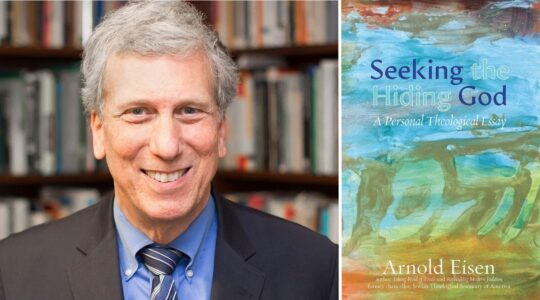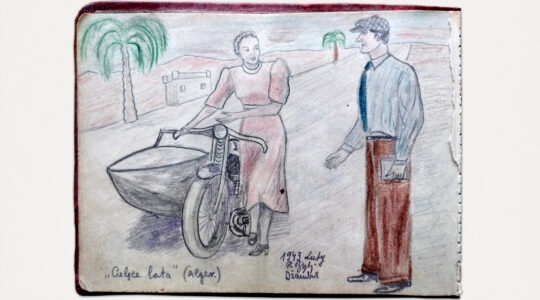On a personal tour last fall at the Metropolitan Museum of Art’s exhibit of Near East artifacts from the ninth through seventh centuries B.C., George Blumenthal could hardly contain his excitement.
Though he is, at 70, a leader in the field of cellular communications, his clear passion is antiquities, with an emphasis on proving the veracity of the Hebrew Bible based on the archeological record. And he has spent millions of dollars funding a wide variety of projects digitizing works of art and historical documents, from the Dead Sea Scrolls to treasures of the Vatican, with the goal of making them accessible online on a global scale.
“I have no personal motive other than wanting the world to see what’s available,” says Blumenthal. He describes his contribution as “a way to honor my parents, honor and preserve my heritage, and leave something for my children.”
On our visit to the Met, Blumenthal led me through the maze of art works, citing chapter and verse along the way on how the inscription on this stele (ancient stone slab with writing on it) over here makes reference to the Israelite’s exodus from Egypt, and that one over there describes a battle the Prophet Isaiah writes of as well. Most importantly, he said with enthusiasm, the writing on the ninth century B.C. stele in front of us, telling of a Damascus leader’s defeat of two kings of Israel and Judah, refers to “the house of David.” Blumenthal explained that as the first non-biblical text to mention the kingship of David by name — secular proof, he believes, of the existence of Jewish history’s greatest king — it should be “meaningful and sacred to Jews, Christians and Muslims.” He ranks it second only to the Dead Sea Scrolls in importance of ancient findings in Israel.
“Every school should [bring students to] come here and see this,” he said.
James Snyder, director of the Israel Museum in Jerusalem, one of many institutions to benefit from Blumenthal’s initiatives and generosity, said, “George’s style is subtle, he’s kind of quiet. But he is very enthusiastic and ahead of the curve. He understands how technology and new media can help us communicate in an incredibly broad way through first-quality visual imagery.”
Snyder cited the response after Blumenthal funded a project done by his close associate, Ardon Bar Hama, an Israeli and world leader in digital photography, on photographing the Dead Sea Scrolls.
“In the first three days [the photos were posted on the museum’s site] there were 1.5 million unique visits from people in 212 countries.
“I didn’t even know there were that many countries,” Snyder added.
Michael Jesselson, a local businessman and philanthropist who shares Blumenthal’s interest in studying and collecting Jewish art and historical objects, described him as “creative, a visionary” —and willing to pay to preserve treasures and share their beauty on the Internet.
“I think of George in Renaissance terms, as patron,” he said, noting that Blumenthal works closely with Bar Hama and subsidizes much of his photographic work for the benefit of nonprofit institutions.
Support the New York Jewish Week
Our nonprofit newsroom depends on readers like you. Make a donation now to support independent Jewish journalism in New York.
“He wants to save the Jewish people,” Jesselson said.
Blumenthal’s current projects with Bar Hama include creating a timeline of American Jewish history for the American Jewish Historical Society (www.ajhs.org), and photographing artifacts and documents associated with a new book on President Lincoln’s relationship with American Jews. The preservation of Hebrew manuscripts in the National Library of Russia may be next on the growing list.
He believes that confirming the accuracy of the Hebrew Bible and enhancing and highlighting significant Jewish objects over the centuries will deepen appreciation of the Jewish narrative. One of his plans is to create a central website to view all of the works he and Bar Hamas have collaborated on.
An admirer of Blumenthal’s work who asked not to be named thinks that given the indifference or lack of awareness of most Jews to Blumenthal’s online efforts, “There is a quixotic quality to his efforts. But I give him credit for trying,” he said.
From Oil Lamps
To Treasures
Blumenthal, who grew up in Cleveland, credits his “fantastic” parents for instilling in him a love of Zionism and the Jewish people, and an appreciation of classical art and history; the latter stemmed from a family visit to Rome and the Colosseum when he was 11.
His serious interest in archaeology and the history of the monotheistic religions began about 20 years ago when he stopped into an antiquities shop near the King David Hotel in Jerusalem and was taken with four oil lamps from the Bronze and Iron Ages, spanning from the days of Abraham to King David. “I thought, ‘these four lamps tell the story of the Jewish people. They’re a national treasure.’” He started buying oil lamps as gifts and later viewed prominent collections of ancient Jewish relics. His hobby became a pursuit, and a subscription to the Biblical Archaeology Review led to a deeper understanding of the history and context of ancient life in what is now the Mideast.
In 2003, Blumenthal said he had an epiphany of sorts. He sought permission from the Zionist Archives to have Bar Hama digitally photograph its collection of Zionist posters. “When I saw how Ardon made those images jump off the page, I realized the potential of what we could do,” he recalled.
The Bar Hama renditions became popular, and a sampling of them graced the wall over the exit ramp of Ben-Gurion Airport several years ago.
With Bar Hama’s work of high quality, great speed and portability — “his studio is in his knapsack,” Blumenthal says — the Israeli photographer has become highly sought after. Blumenthal is usually alongside, demonstrating to museums and other institutions how they can save time and money, and enhance their collections, through digitization. He often encourages them to make a sampling of the Bar Hama photos to show to potential donors as a means of fundraising.
“I’ve never met anyone like George,” said Barbara Haws, archivist and historian for the New York Philharmonic Orchestra. Blumenthal’s “long-term, big vision,” she said, has led the Philharmonic to undertake a project that will digitize over four million pages, going back to its creation in 1842.
Support the New York Jewish Week
Our nonprofit newsroom depends on readers like you. Make a donation now to support independent Jewish journalism in New York.
She said that thanks to Bar Hama’s work, “we can get donors excited about the project” by showing them, for example, Leonard Bernstein’s debut program from 1942, the memo of his being hired, showing how much he was paid, and more. All of it can be read on original documents.
“No one else has such a big idea to go around the world and digitize,” said Haws. “We need more Georges.”
In conversation, noting his interest in Jewish-Christian-Muslim relations, Blumenthal can rattle off a dozen past, current and upcoming projects, with detailed stories, one morphing into the next. Photographing the Cairo Geniza for the Jewish Theological Seminary. Working with a Christian Evangelical group on their The Bible In Literature project. A venture with YIVO. Getting access to closely guarded vaults at the Vatican so Bar Hama can photograph four Hebrew manuscripts. At Oxford, a Mishnah Torah signed by Maimonides. Working with the office of the prime minister of Israel to restore Jewish heritage sites and create websites. The list goes on, transcending theological boundaries.
“I spend a lot of time documenting original source material,” Blumenthal says. “It’s exciting to offer historical proof of the contextuality of the Hebrew Bible, to show that King David and Hezekiah and Isaiah were real people.”
A key motivation for his work is “connecting young people to Israel,” he says, especially at a time of concern over younger Jews distancing themselves from the Jewish state. As a final point, he adds that he wants to prod fellow philanthropists to leverage their dollars thoughtfully. “I hope my work shows that you can do a lot with a relatively little bit of money,” he says, “if you put your energy into it.”
The New York Jewish Week brings you the stories behind the headlines, keeping you connected to Jewish life in New York. Help sustain the reporting you trust by donating today.





